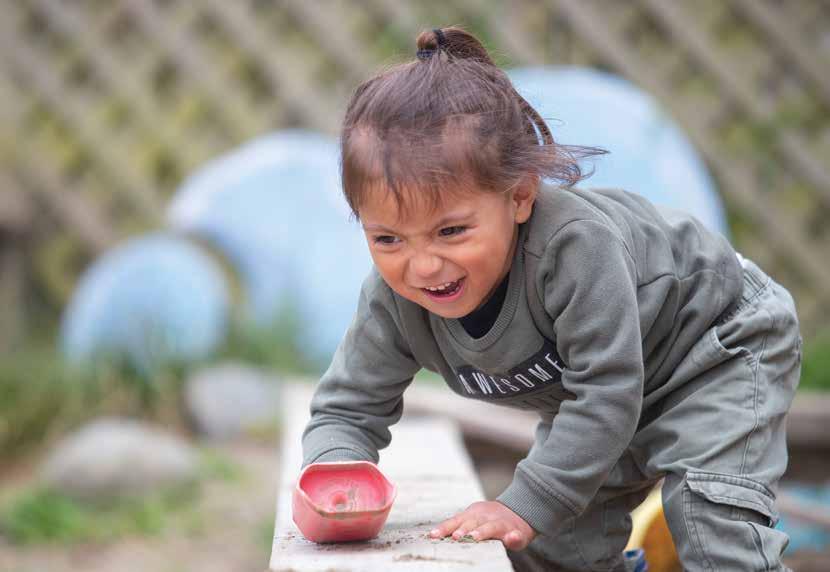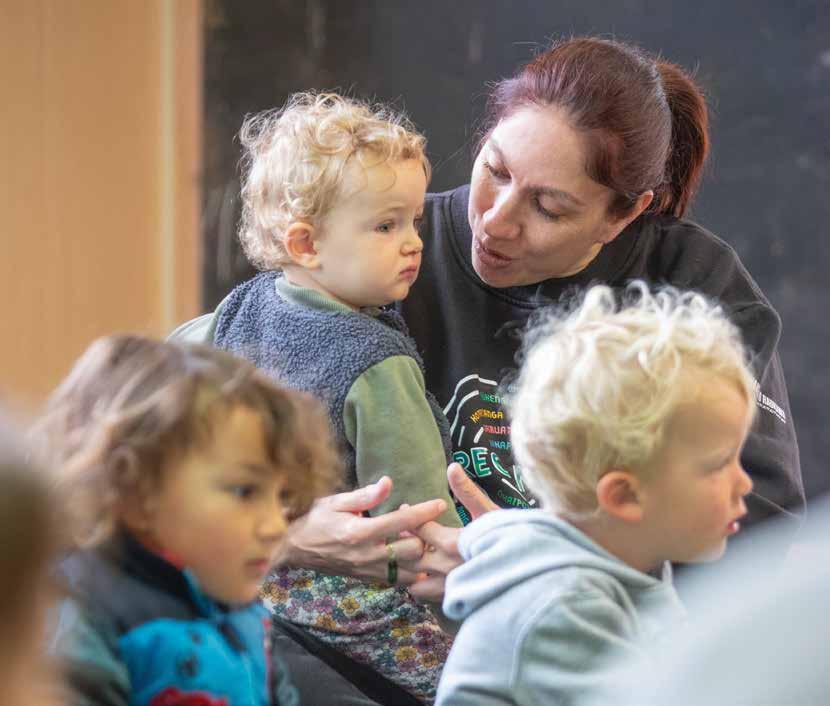Learning to listen and talk

A guide for parents and

In partnership with Resource developed by
–
Te ako ki te whakarongo me te kōrero
kaiako
Kupu Whakataki | Introduction
During the early years, tamariki are learning and absorbing information everywhere, all the time. One of the most important skills they develop is oral language. This includes talking, listening, and understanding what others say. It seems simple, but learning to communicate is actually a complex process requiring patience and practice.
This resource offers information and three simple activities you can do with tamariki to understand and grow their talking and listening skills. It is based on research in English language assessment only.
Tamariki identify speech sounds to make sense of words and sentences. Whānau conversations role-model talking and listening. As tamariki grow, they begin to communicate thoughts and feelings, ask questions, have conversations, and learn.
He akoranga mutunga kore | Lifelong learning
Talking and listening impact all areas of life from whānau relationships and early friendships to lifelong learning. Talking and listening skills contribute to:

1. Self-confidence, self-expression, and belonging
2. Social and emotional wellbeing, and relationships with others
3. Active participation in the world around them
4. Reading, writing, language, and literacy
This resource focuses on sounds and spoken language. Tamariki who are deaf or hard of hearing may choose New Zealand Sign Language as their primary means of communication. Sign language is a complete and complex language, using hand gestures, facial expressions, and body movements.
2
Te ako, te whakarongo me te tākarokaro
–
Learning, listening, having fun
Whānau and kaiako can support talking and listening by providing regular opportunities for tamariki to learn new words, share ideas, and practise them in everyday situations.
Be patient and repeat words and phrases to encourage tamariki.
Things to do
Conversation:
• Talk about what you’re doing, what you can see, and places you’re going. Talk about what you are doing while you're cooking, driving, gardening, and shopping. Talk about people and point out animals or objects even if the child isn’t responding.
• Take turns talking and listening (serve and return like tennis). Play games that involve taking turns, for example, mili mili pati ā (Samoan chant), peeka-boo, or I-spy.
• Share observations, retell stories, and ask open-ended questions, for example, ask: What is the cat doing? Instead of, can you see the cat eating? Repeat words and statements so they become familiar.
• Allow time for tamariki to lead and control the discussion.
• Talk about things that interest them, for example: Remember when we… or Let’s go swimming.
• Practise new words, ideas, and language skills. Encourage whole sentences, like: We are sitting on the bus. I see a bird.
Screen time:
• Research shows that too much screen time can interfere with how tamariki listen and talk. Sit with them while they’re watching screens and talk about the content.
Play to learn:
• Play is a natural and enjoyable way of learning!
• Games like I-spy encourage listening and using new words.
• Pretend play improves listening skills and social interaction.
Books:
• Read books and other printed words out loud, for example, posters and signs. Reading builds vocabulary, language structure, and comprehension.
• Read books to tamariki regularly to encourage the love of books. Reading to tamariki from a young age supports language and literacy. It’s okay if tamariki want to read the same book over and over and over…
Songs and rhymes:
• Sing songs, say rhymes, and play word games while you’re in the car or doing everyday activities like getting dressed or getting ready for bedtime.
• Repeating language patterns using rhythm and melodies helps tamariki remember words and phrases.
3
He tirohanga whānui | The big picture
Ko te kai a te rangatira, he kōrero | The sustenance of a leader is verbal communication
The language learning and development pyramid depicts the overall sequence in which tamariki develop nonverbal and vocal communication abilities. Although some skills (such as attention and language comprehension) might grow together, the pyramid* shows the general progression of typical language development and the capabilities that are the foundations for more complex skills. It assumes tamariki are curious, safe, and have opportunities to learn.
These steps may not happen one after the other. Some steps might develop at the same time. However, in general, it is not helpful to focus on perfecting speech sounds if the child is not yet ready to engage in shared attention or doesn’t understand when you call their name.
*The above language pyramid is based on the example on the Children’s Therapy Website. The origin of the language development pyramid is not attributed to any single person or organization. It is a widely recognized framework for understanding the building blocks of language development in young children, used by many professionals in the fields of speechlanguage therapy, education, and child development to guide their work with children.
Language Development Pyramid. (n.d.). Children’s Therapy Place. Retrieved April 21, 2023, from https://childrenstherapyplace.com/language-development-pyramid/
|
SOUNDS clarity | pronunciation | more complex words, phrases
talking | signing | vocabulary | grammar
using accurate speech sounds
directions | receptive language | understanding questions
SKILLS
together | playing with toys and objects | using imagination
AND FOCUS
| looking | listening | short tasks
PRE-VERBAL eye contact | taking turns | shared attention
pointing SPEECH
EXPRESSING
Gradually
UNDERSTANDING following
PLAY
playing
ATTENTION
waiting
5
Ngā tūmahi kōrero me te whakarongo –
Talking and listening activities
These activities are designed for tamariki between about 3 and 6 years old. Use them to identify tamariki who might be having difficulty talking and listening. Adapt these activities to any language by starting with simple words and sounds before building to more complex phrases and sentences.
Get ready:
• Find a time and space without distractions.
• Spend a few minutes on each activity.
• Relax and be playful. Feel free to use props such as toys or puppets.
• Record the child’s response or make notes so you can review their progress.
• Praise them for something you noticed, for example, attention, attempt, patience, or accuracy.
Te tautoko atu | Providing support
While talking and listening skills develop naturally for most tamariki, how quickly they learn may differ for many reasons. Tamariki may respond well to a different way of learning.

The activities below can help whānau and kaiako recognise how tamariki learn, where they’re up to, and include suggestions to encourage talking and listening together.
At first, tamariki won’t say all words perfectly, that’s okay! It’s about having fun with sounds and words and building confidence.
6
1. Te tōai i ngā rerenga kōrero ngāwari | Repeating simple sentences
This activity shows how well tamariki understand the structure of language.
Asking tamariki to repeat simple sentences can show how their language is developing, their understanding of language rules, and how to use words in sentences. Some tamariki might be able to repeat just a few words, especially in longer sentences. Talking and listening skills are affected by the age of tamariki, how many languages they are learning, and how well they hear.
Actions
• Explain: I’m going to say something then you say it back to me.
• Say a short phrase. Start with simple, two-word sentences and build to more complex sentences. Here are some examples:
- Fish swim
- The dog barked
- I love eating yellow bananas
- The fish is swimming
- When it’s hot my ice cream melts
- Sometimes when I’m sad, going for a walk helps me feel better.
• Ask tamariki to repeat the phrase back to you.
• You can repeat the phrase, and ask tamariki to repeat it again.
• Four phrases will likely be enough.
• Listen for:
- quick and natural responses
- correct words and sounds
- repeating words in the same order.
If tamariki are not engaging or responding, try another activity. Suggestions below.
Activities to build an understanding of language structure
• Singing and music
• Rhymes
• Shared book reading
• Games like I-spy
• Turn-taking games
• Talk during everyday activities like cooking and bathtime
• Talk about what you see and where you’re going while travelling and walking.
7
2. Ngā kupu nenekara | Nonsense words
Many tamariki enjoy this activity – it’s about listening, talking, and exposing them to new sounds and combining sounds in words. Add your own words and sounds.
Actions
• Explain: I’m going to say a silly, made-up word.
• Say a silly made-up word, for example:
- Terg
- Blorf - Norg
- Theesterp
- Mungerbleem
• Ask them to repeat the word.
• They may want to make up their own words which you can repeat.
• Listen for the sounds tamariki say clearly and sounds they are still learning.
Activities to build listening and hearing
• Rhyming games
• I-spy games
• Shared book reading
• Nonsense poems
• Rhyme and naming games.
8
3. Te kōrero mō ngā pikitia | Talking about a picture
Recognising words and understanding how to use different types of words to describe, explain, question, and identify is essential. It also shows how tamariki are putting words together, and how comfortable they are talking with people.
Actions
• Explain: Let’s look at some pictures, for example:
- a favourite picture book with a range of pictures
- interesting paintings, drawings, and photos
- interactive books.
• Say, Tell me what you see, or Tell me about this picture.
• You may need to start with a comment: I can see the dog running…
• Relax, and stay quiet for 10 to 20 seconds to let them think.
• Use verbal encouragement: great, yes, that’s right, anything else?
• Stop when the child no longer responds to prompts.
• Listen for:
- different types of words: action and naming words, pronouns like she and it, and adjectives like colour words
- confidence in sharing
- thinking and feeling words.
Activities to build vocabulary
• Shared reading and talking about reading
• Making comments and waiting for tamariki to talk before asking a question
• Adding new words when talking with tamariki
• Tune in, talk more, and take turns.
9
What other help is available?
Awareness of oral language pathways allows kaiako and whānau to understand tamariki needs and provide support.

If you have ongoing concerns about a child’s oral language or hearing, talk with whānau, kaiako, kaimahi | staff, or ask your doctor for a referral to an audiologist or speech therapist for additional professional support.
Kupu Whakamihi | Acknowledgements
Te One, S., McAllister, T., Whiting, S. (2021). Te hautū i te awa whiria o ako Supporting pathways to lifelong learning for children in English-medium schools. CORE Education | Tātai Aho Rau, and Rātā Foundation.

In partnership with Resource developed by






